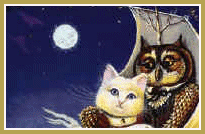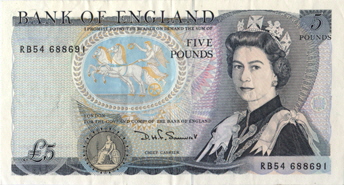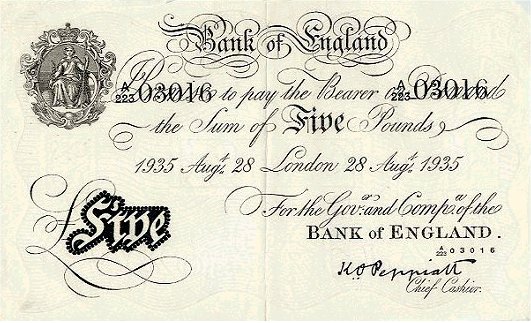The Owl and the Pussy-Cat
| The Owl and the Pussy-Cat went to sea In a beautiful pea-green boat: They took some honey, and plenty of money Wrapped up in a five-pound note. |
| |
| The Owl looked up to the stars above, And sang to a small guitar, "O lovely Pussy, O Pussy, my love, What a beautiful Pussy you are, You are, You are! What a beautiful Pussy you are!" |
|
| Pussy said to the Owl, "You elegant fowl, How charmingly sweet you sing! Oh! let us be married; too long we have tarried: But what shall we do for a ring?" They sailed away, for a year and a day, To the land where the bong-tree grows; And there in a wood a Piggy-wig stood, With a ring at the end of his nose, His nose, His nose, With a ring at the end of his nose. |  |
"Dear Pig, are you willing to sell for one shilling
Your ring?" Said the Piggy, "I will." So they took it away, and were married next day By the Turkey who lives on the hill. They dined on mince and slices of quince, Which they ate with a runcible spoon; |  |
| And hand in hand on the edge of the sand They danced by the light of the moon, The moon, The moon, They danced by the light of the moon. |  |
The Owl and the Pussycat - 1871 - by Edward Lear
| About the Author:EDWARD LEAR - b1812 London, England--d.1888,Italy The twentieth child of Jeremiah Lear, a London stockbroker, and his wife Ann, Lear grew up to become a prolific writer as well as a talented artist of both landscapes and birds . Lear also gave drawing lessons to Queen Victoria of England. Lear was particularly enchanted with nonsense poetry, and devoted a number of his books to collections of such poems as this; |  Portrait by Wilhelm Marstrand |
| There was an Old Man with a beard, Who said, 'It is just as I feared! Two Owls and a Hen, Four Larks and a Wren, Have all built their nests in my beard!' |  |
Edward Lear had begun to pen the sequel, The Children of The Owl and the Pussycat, but sections of the poem still remained incomplete at the time of his death in 1888. The portion that was complete, was published posthumously (meaning, after his death) in 1938.
It begins;
The Children of the Owl and the Pussycat
Our mother was the Pussy-cat,
our father was the Owl,
And so we're partly little beasts
and partly little fowl,
The brothers of our family
have feathers and they hoot,
While all the sisters dress in fur
and have long tails to boot.
The Edward Lear website will let you learn more about this talented individual.
About the Illustrator: Donna L. Derstine
 | The Owl and the Pussycat by: Donna L. Derstine (1959 - ) A painter in the American Primitive Style, Donna grew up in rural Buck's County, Pennsylvania where the countryside reflects an early American vista with stone farmhouses and barns, rolling pastures and working farms. Her mother instilled a creative sensibility in viewing the world and that influence along with the artist's love of animals and nature, became woven into her art at an early age. Donna's art can be found in many commercial art galleries . This charming image would be a delightful addition to a child's room. |
VOCABULARY:
Antique Words: "runcible" The term runcible appears in English for the first time in E. Lear's nonsense verse. As the Oxford English Dictionary notes, the word has taken on a life of its own.The Oxford English Dictionary2 on CD-ROM © Copyright Oxford University Press 1994 provides this definition and citations:
| runcible, adjective. A nonsense word used by Edward Lear in runcible cat, hat, etc., and esp. in runcible spoon, in later use applied to a kind of fork used for pickles, etc., curved like a spoon and having three broad prongs of which one has a sharp edge. E. Lear 1871 Owl & Pussy-Cat in Nonsense Songs They dined on mince, and slices of quince, Which they ate with a runcible spoon. |  |
Our thanks to Ben Mottram from the U.K. for providing the 1935 version. |   |




0 comments:
Post a Comment